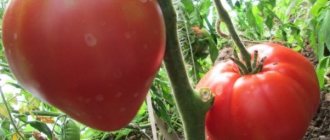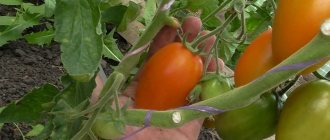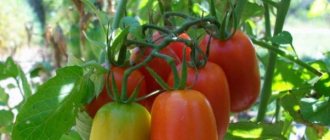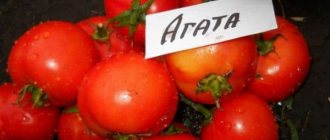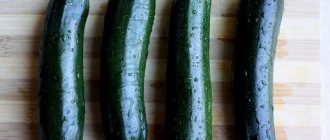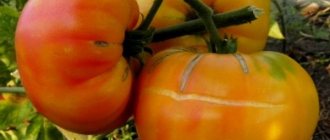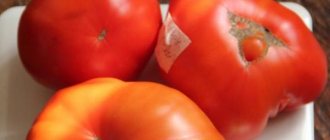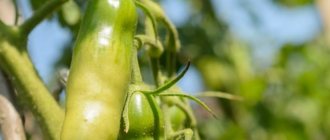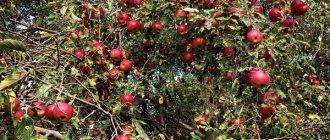» Vegetable growing » Tomatoes » Growing tomato Verochka
0
8306
Article rating
Most early-ripening tomatoes have their typical sourness. Tomato Verochka is one of the exceptions. Many were captivated by the taste of this hybrid. It is possible to achieve a high plant yield provided that all growing rules are strictly followed.
- Growing rules
- Sowing seedlings
- Transplanting seedlings
- Care
- Diseases and pests
- Reviews from gardeners
Growing tomato Verochka
History of the variety's creation
A new early-ripening tomato variety, Verochka, was bred by breeders from agriculture and received its name in honor of the youngest daughter of the originator of the variety.
This tomato was bred at the beginning of this century, but has not yet been included in the Russian State Register of Agricultural Achievements.
But thanks to its early ripeness, high yield and the ability to grow in garden beds and in greenhouse conditions, the Verochka tomato has already become popular among Russian vegetable growers.
Photo of tomato Verochka F1
Area of application of fruits
Verochka F1 was developed for universal use. Tomatoes are great for first vegetable salads, but their high taste characteristics allow them to be consumed fresh on their own. Experts classify them as a dessert type.
Related article:
Caring for tomatoes in greenhouse conditions
The high concentration of vegetable sugar in the pulp makes them a good option for pickling. If you take into account the average weight of tomatoes, it becomes clear that they are also used for marinades. After heat treatment, they do not burst or lose their integrity. The hybrid is also suitable for the production of juices or ketchups.
Tomato Verochka: description of a new promising variety
The Verochka tomato belongs to the super-determinate type - the height of the shoots when grown in open ground reaches 0.6 m, but in greenhouses this tomato can reach a height of 1.0 m. The bushes are strong and strong, but quite compact, they look beautiful and neat. The shoots are actively formed, they are powerful and quite leafy.
The tomato hybrid Verochka F1 is classified as an early-ripening variety, so from the moment of germination of the seed material to the harvesting of the first ripe product, just under 3 months pass.
On a note!
Many vegetable growers note that in the southern regions of Russia, the first fruits from Verochka hybrid tomatoes are harvested after 2.5 months.
The foliage is quite large, oval-elongated, of a simple type, attached to the shoots by small petioles, can reach 25 cm in length, and the width is approximately the same. The outer leaf plates are slightly wrinkled, with a slight shine, and a rich emerald color.
The flowers that appear on the shoots are ordinary, small in size, yellow in color, they are collected from the inflorescence-tassel, the first of which appears after 6-7 leaves, and each subsequent one after 2 leaves.
During the process of fruit ripening, Verochka tomato bushes look very beautiful - small clusters with 4-5 ripening tomatoes give the compact plants a decorative appearance. The racemose clusters can reach 18-20 cm in length.
Interesting!
The size of the fruits in the upper and lower parts of Verochka tomato bushes is approximately the same. One of the advantages of this hybrid is that the fruits do not become smaller, and the last ripening tomatoes are not smaller than those that ripened first.
SUPER EARLY TOMATO WITH TASTE! — VEROCHKA F1 — video
The ripe tomatoes of the Verochka hybrid are smooth, round in shape, compacted, with dense skin and thick walls; slight ribbing often appears in the area of the stalk. The average weight of ripe Verochka tomatoes is about 140-150 g.
The compacted thin glossy skin of unripe tomatoes has a light green color, and at the stage of full ripening it has a rich red color, without the dark green spot in the area of the stalk that is characteristic of other varieties.
The pulp of ripe tomatoes is fleshy and sufficiently juicy. The aroma of ripe fruits is typically tomato.
The taste qualities of Verochka tomatoes are considered exemplary - gourmets compare sweet tomatoes with virtually no sourness to varietal tomatoes.
The fruits have 4-5 seed cells with a small amount of seed material at the milky ripeness stage.
Thanks to the thick skin, the fruits are not prone to cracking, tolerate transportation well at any distance, and can be stored in appropriate conditions for up to two weeks.
Care
Measures to care for the hybrid include regular watering, weeding, loosening, fertilizing, and bush formation.
Watering should be moderate and carried out as the soil dries. To do this, it is recommended to use warm, settled water. Watering must be carried out strictly in the plant's plant area, without affecting the stem of the crop itself, in order to prevent the occurrence of rot and fungi.
():
The most accessible method of watering for amateur vegetable growers is flood watering, when water is supplied to the garden bed from a hose placed on the ground. In this case, the water pressure should be small so as not to erode the ground and create splashes, because “Dirty watering” can provoke the appearance of fungal diseases.
After each watering, it is advisable to loosen the soil. This will improve oxygen access to the root system and retain moisture in the ground for a longer time.
Also, during the loosening process, weeds will be destroyed, which draw nutrients from the soil near the crop. To reduce their number and reduce the number of waterings, the soil can be mulched.
Fertilizing Verochka F1 tomatoes should be done once every 14-15 days. Depending on the condition of the tomato plants, Agro recommends using complex mineral and organic fertilizers designed specifically for tomatoes as fertilizers.
You should not give up traditional methods (nettle infusion, spraying with antiseptics, using boric acid, etc.).
When growing tomatoes in a greenhouse, the bush is formed into 2-3 stems; in open ground, its formation into 3-4 stems gives maximum results.
Diseases and pests
Tomato Verochka F1 is resistant to diseases such as blossom end rot, but is more susceptible to others: tobacco mosaic, late blight, alternaria. To prevent them, it is better to use fungicides, which are also sold by.
The main pests for tomatoes are aphids, Colorado potato beetles, mole crickets, and slugs. Drugs such as “Marshal” and “Aktellik” have proven themselves to be effective against them; special traps are used for slugs.
SUPER EARLY TOMATO WITH TASTE! — VEROCHKA F1
I WILL DEFINITELY PLANT THESE TOMATOES!!!NEW THIS YEAR!
tomato Verochka F1
Main characteristics
Hybrid Verochka is grown in greenhouse conditions and in open ground garden beds. In protected soil, fruit harvesting begins earlier, but in garden beds under the rays of the sun, more sugars are formed in the fruits, so these tomatoes are much sweeter and tastier.
The tomato hybrid Verochka tolerates changes in weather conditions well and copes well with heat (but subject to regular watering). At the same time, the sun's rays, even at midday, do not cause significant damage to foliage and ripening tomatoes.
Productivity of the Verochka variety
In greenhouses, the first fruits of the Verochka tomato are harvested in the first ten days of July, but the main harvest usually ripens during August, and the last fruits can ripen in September.
When growing this hybrid in greenhouse conditions, up to 15-17 kg of ripe fruits can be collected from each square of area, and about 4 kg of ripe products can be collected from one low Verochka tomato bush.
When grown in garden beds, the yield of the variety is somewhat lower.
Tomato VEROCHKA collection and results for the season - video
Characteristics
- As already mentioned, Verochka belongs to the early ripening hybrids. From the moment of full shoots to the maturity of the first fruits, only 85 - 90 days pass. In hot climates, the ripening process can begin in record time - after just 75 days;
- the yield of commercial products in protected soil exceeds 15 kg per 1 square meter. According to the author himself, with good agricultural technology and normal weather conditions, 5 kg of selected fruits can be harvested from one low bush;
- in protected soil, the first tomatoes begin to ripen in the first ten days of July, the variety produces the bulk of the harvest in August, but even in September you can still harvest a lot of ripe, tasty tomatoes;
- The crop can be planted both in protected soil and in open soil. In a greenhouse, the fruiting process will, of course, begin earlier. But tomatoes grown in a garden bed illuminated by the sun will taste even sweeter;
- thanks to the strong skin, the fruits do not crack and retain their presentation;
- The popularity of the culture is facilitated by strong immunity. The fruits are highly resistant to blossom end rot, and the plant itself is perfectly resistant to tobacco mosaic virus and Alternaria blight. Thanks to the early ripening of the crop, Verochka is able to escape late blight;
- Numerous responses indicate the high resistance of tomato to adverse weather conditions. The hybrid is successfully grown in protected soil even in the Ural region;
- The heat resistance of the variety is also noted, especially appreciated in the southern regions. Tomatoes are also resistant to the active sun, which does not leave any marks on the surface of the fruit;
- The ripe product withstands transportation perfectly, does not wrinkle, and does not lose marketability. Keeping quality is also excellent;
- the method of use, as the author claims, is universal. Tasty and healthy tomatoes will form the basis of a vitamin salad. Due to the high sugar content in the pulp, tomatoes also have excellent pickling qualities, and the average weight of the fruit is considered ideal for whole-fruit canning. Verochka's harvest can also be processed, resulting in high-quality tomato products.
Diseases and pests
Another undoubted advantage of this vegetable crop is its high immunity to tomato diseases. Therefore, Verochka tomato fruits are practically not affected by blossom end rot; the bushes are resistant to tobacco mosaic virus and Alternaria blight.
Since tomatoes of this variety ripen in the first half of summer, they are not affected by late blight, the peak of which occurs in the second half of summer.
There is a great tool:
iodine from late blight of tomatoes
In the video, Verochka tomatoes from Partner
If you grew Verochka tomatoes, please write whether you liked them or not. What was the yield and taste of the fruits like under your climatic conditions? How do you rate the disease resistance of this variety? Briefly describe the advantages and disadvantages of this tomato in your opinion. If possible, attach a photo of your tomatoes to your comment. Thank you!
Your reviews of the Verochka tomato and additions to the description will help many gardeners evaluate this variety more objectively and decide whether it is worth planting or not.
Advantages and disadvantages
Experts include the main advantages of the Verochka tomato:
- early ripening of the crop;
- high yield for a determinate low-growing variety;
- the possibility of growing Verochka tomato in open ground and in a greenhouse in most Russian regions;
- the fruits are not prone to cracking due to the compacted skin, so they tolerate heat treatment well, maintaining a beautiful appearance when pickled and salted;
- the harvested crop can be transported to any distance and stored in a cool place for a long time;
- thanks to increased immunity, the Verochka tomato is resistant to many diseases;
- the Verochka tomato is resistant to sudden fluctuations in weather conditions, as well as heat, which makes it possible to grow this hybrid in the south of Russia;
- the collected fruits are of universal use.
The Verochka tomato has virtually no downsides. Except for the fact that it will not be possible to collect seeds from the fruits of the hybrid and they have to be purchased annually in specialized stores.
How to grow tomato seedlings Verochka
The specific timing of planting seed depends on where the seedlings will grow in the future:
when growing Verochka tomato in open ground, seeds should be sown at the end of March; if the tomato is grown in greenhouse conditions, then the seed should be sown in early March.
Important!
It must be remembered that seedlings should be planted in a permanent place at the age of 55-60 days, based on this, a specific planting date is set.
A nutritious substrate for growing seedlings can be bought at a gardening store, or you can prepare it at home by mixing garden soil and high-moor peat in equal parts.
In order to avoid picking seedlings in the future, it is better to plant the seeds immediately in separate containers - peat or plastic cups. Two seeds are planted in each container, and then the weaker one is simply removed.
Before germination, the cups are covered with polyethylene and left in a warm, bright place.
5 main mistakes when growing tomato seedlings - video
When the sprouts appear, the polyethylene is removed, and the cups are transferred to the windowsill and grown at a temperature of about 20 degrees Celsius.
If the seedlings of this tomato are grown in common containers, then at the stage of two permanent leaves they are planted in different containers.
Verochka tomato seedlings are transplanted to a permanent location when the plants have at least 5-7 permanent leaves and their height is at least 15 cm.
No more than 4 plants are planted on each square of area.
Planting and care
Successful cultivation involves the same rules that apply to tomatoes as standard. However, this tomato has some nuances.
Sowing
The time when you should start planting depends on where you plan to grow the tomatoes next:
- for greenhouses and booths - the first week of March;
- for the garden - after March 20.
You can use purchased soil for seedlings, or you can prepare the substrate yourself from black soil with peat in equal parts.
After sowing, the containers are covered with a transparent film and placed in a bright place with a temperature of +25°C. The soil does not need to be watered before the first seedlings appear; the moisture that is in the soil after planting is sufficient. As soon as the seedlings hatch, the cover is removed. From this point on, you need to carefully monitor the humidity. The container is moved to a cooler place - +17-+19°C. Good lighting is also important. If there are no window sills with normal insolation, you can add additional light to the tomatoes using a fluorescent lamp or phytolamp.
Related article:
Growing tomatoes without seedlings - varieties, advantages and disadvantages of the method
Transplantation to a permanent place
Transplantation is performed 50-55 days after the seedlings appear. By this time, the first buds may appear on the bushes. Planting is carried out at the following times:
- greenhouse - early May;
- vegetable garden - end of May - first week of June.
The recommended depth of planting holes is 15 cm, but it is better to focus on the size of the root system. The roots should be freely located inside. You can place a handful of humus at the very bottom.
Important! How to grow tomatoes in open ground
The distance between rows is 70 cm, and neighboring plants in a row should be 50 cm apart from each other.
Too dense placement worsens the yield of this hybrid.
Fresh plantings are watered abundantly: for one plant - 10 liters of water at room temperature. The earth will settle, after which it will be sprinkled on top.
Related article:
What are standard tomatoes
Despite the fact that the variety is not tall, the bush may fall off under the weight of ripening tomatoes. To avoid this, supports are made at the time of planting. The tying begins immediately after rooting and resumption of growth.
Watering
Watering once a week is recommended. At the same time, water should not get on the leaves: this will protect the plant from burns and fungal diseases. Ideal if there is drip irrigation. During rainy periods, to prevent getting wet, you can throw films over the beds. This is easy to do due to the compact size of the bushes.
Loosening
For good aeration of the roots, it is recommended to loosen after each watering. This procedure will also help get rid of weeds and prevent minerals from salting out on the soil surface. To reduce loosening efforts, you can mulch.
Related article:
How to grow tomatoes in a greenhouse
Feeding
To get a good harvest you will need fertilizing. They are performed twice a month. It is recommended to use the organic complex once, and the mineral complex once. Fertilizers are applied over wet soil. The last time feeding is carried out 2-3 weeks before harvesting the fruits.
Bush formation
Forming allows you to get the maximum yield and harvest it as early as possible. In the greenhouse, all side shoots are removed, leaving only 1-2. In the garden, the root system develops more powerful and stronger, so its potential is enough for 3-4 main stems. For this purpose, the strongest and thickest offspring are chosen.
Verochka tomatoes: reviews from those who planted and grew the variety
Katerina, 47 years old, Orenburg region: Several years ago, my husband built a greenhouse on our garden plot, in which we now annually grow vegetables for ourselves and for growing. For a couple of years I have been growing the Verochka tomato in it - a hybrid with tasty fruits, compact, when planting up to 5 bushes of the variety per square area, the yields are high. I preserve the fruits, make lecho and tomato paste for the winter, and leave some for food.
Sveta, 40 years old, Volgograd region: I grow Verochka tomato for food and for tasty preparations. The fruits are medium in size and can be preserved whole. Their sweet taste makes them great for salads. The bushes themselves easily tolerate heat and bad weather, practically do not get sick, and do not require special care. I recommend Verochka tomato to everyone for growing in open ground and in a greenhouse.
Oleg, 55 years old, Samara region: We grow various vegetables in our large garden for further sale. Among the early tomatoes, I liked the Verochka hybrid - the bushes are compact, they can be planted 1 m2 more than tall varieties of tomatoes. The bushes were formed into 3 shoots, the harvest turned out to be quite large, and buyers snapped up the tomatoes with great pleasure. In the future, we will allocate a larger area for this variety.
The hybrid tomato Verochka has many advantages - early ripening, productive, compact, resistant to sudden changes in temperature, periods of heat and rain, versatility of the harvest
. All these positive qualities were appreciated by Russian vegetable growers, who have been successfully growing this tomato in their garden beds and greenhouses for several years, even despite the fact that the Verochka tomato has not yet been included in the State Register.
Features of agricultural technology of the variety
Recommended density of indeterminate bushes on the site:
- 4-5 copies per 1 sq. m when forming them into 1-2 stems;
- 3 copies per 1 sq. m. when formed into 2-3 stems.
Based on these data, calculate the landing pattern. Sowing seeds according to the standard scheme, 2 months in advance. before the planned transplant into greenhouse soil. The first inflorescence of rooted seedlings will appear after the 9th leaf. The rest of the care in the ground does not differ from that typical for tomatoes. Read this article on how to transplant seedlings into a greenhouse.
Advice. Install trellises or other support along with planting seedlings. Tie up the bushes immediately.

